If you are curious about how aqueducts and sewer systems function, check out the London Museum of Water & Steam. This museum is perfect for children and adults who are eager to learn about the process of making Thames water drinkable and the fascinating history of British sewers. The sewers in Britain developed much later than the sewers of continental Europe and were known for being quite smelly.
Table of Contents
What’s on at the London Museum of Water & Steam
The Museum of Water & Steam in London is in the historic home of Kew Bridge Waterworks. It showcases the evolution of the water supply system in the city. One of the museum’s main attractions is the live demonstration of the massive steam pumps used to move water.
PLAN YOUR TRIP TO LONDON
Prepare for your London adventure by securing the London All-Inclusive Pass, granting access to 80+ attractions, guided tours, and a Thames adventure with the Hop-On-Hop-Off Big Bus and Uber Boats by Thames Clippers.
Stay connected in the UK with a giffgaff free SIM or an Airalo eSim for data coverage throughout your London journey. And don’t forget to get Heymondo Travel Insurance, which covers any inconveniences during your trip!
The exhibition is interactive and informative. It showcases the pumping, filtering, and cleaning of Thames water. It also highlights the development of sewage systems from the Victorian era to the present day. The exhibition includes some shocking facts about the poor sanitation of the past. Visitors can also admire the magnificent steam pumps, now forgotten.
The museum galleries are fascinating for everyone, especially children. The little ones can enjoy the specially designed attractions demonstrating the pumping systems. However, the water filtration systems and sewers interest visitors of all ages.
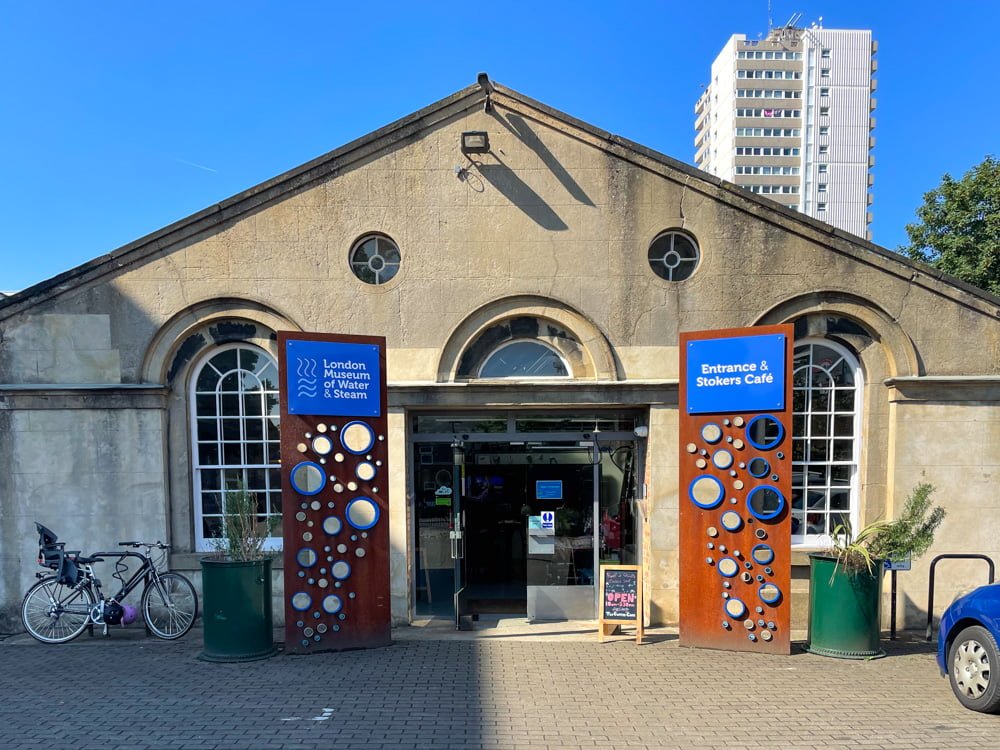
How London’s water supply worked
The Waterworks Gallery provides information on the workings and hygiene of London’s water supply. If you are from continental Europe, you may be familiar with waterworks and sewage systems dating back to Roman times. However, in the United Kingdom, the development of the water network was much later and with less attention to hygiene.
Before the 16th century, water for domestic use in London was collected from the Thames or rivers and was clean enough for use. Pipes carried the water from the springs to the city streets, where it could be collected. With the growth of the city, the water demand increased.
The London Bridge Water Works Company, founded in 1581, was the first company in the world to bring water into homes. They used water wheels installed under the arches of London Bridge to pump water into the houses of those who could afford the service. By 1850, eight water companies in London operated an extensive supply network throughout the city, pumping water from sites such as Kew Bridge, now the museum site.
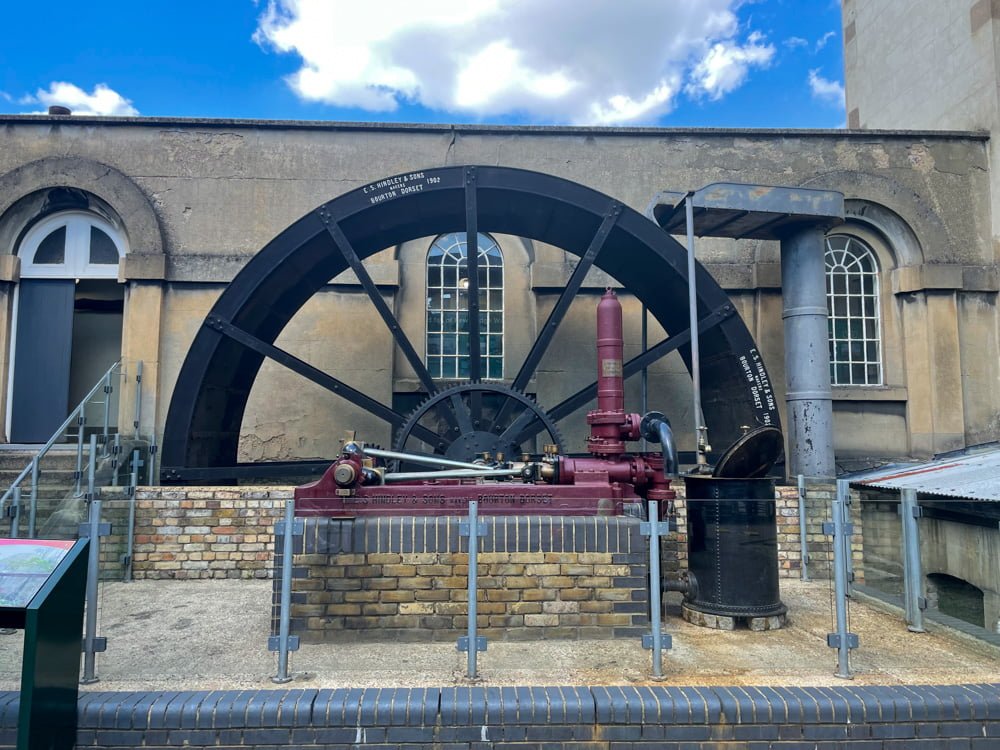
The birth of the London sewer system
The population of London had increased significantly by 1850. However, the sewer system was still rudimentary. It involved dumping dirty water and chamber pot contents directly into rivers or streets. Many small rivers in London were covered to hide the disgusting smell, but the sewage still made its way into the Thames.
The Industrial Revolution worsened the situation, adding factory sewage to the mix. The problem peaked in 1858, known as The Great Stink when the smell of the Thames was so unbearable that the British Parliament had to adjourn.
Eventually, people realised that throwing waste into rivers was not a good idea, and the first modern sewers were built in Victorian England. The first sewage pumping station in London, the Crossness Pumping Station, was established shortly after the opening of a similar facility in Liverpool.
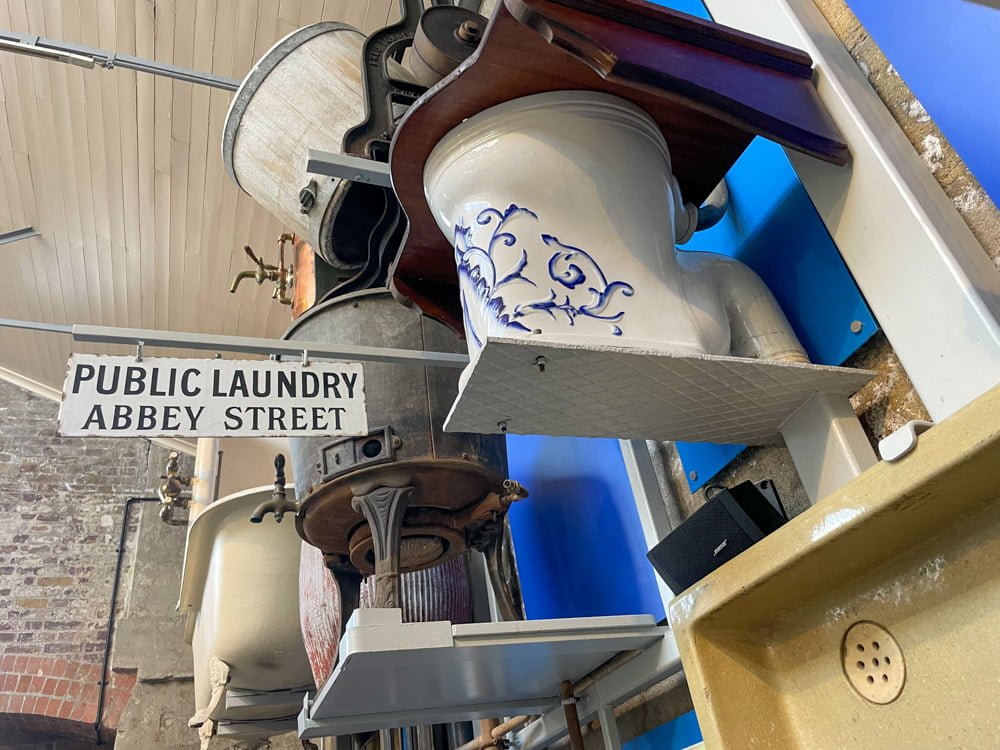
London’s deadly drinking water
Apart from the unpleasant odour, a big issue with London’s water during the 19th century was micro-organisms in the Thames River, which caused diseases like cholera and typhus. At that time, people were unaware of these micro-organisms and used to drink the same sewage water. The authorities were more concerned with getting rid of the stench than addressing the root cause of the diseases.
The Museum of Water & Steam in London highlights the contribution of John Snow, a British physician who experimented with London’s waters in 1854. Snow observed that cholera cases dropped significantly among Londoners who received water from a cleaner part of the Thames. This experiment laid the foundation for epidemiology and hygiene in medicine.
However, the authorities only took Snow’s theory seriously in the subsequent cholera epidemic. Victorian population, scientists, and politicians had difficulty accepting the idea that drinking water contaminated with sewage could spread diseases.
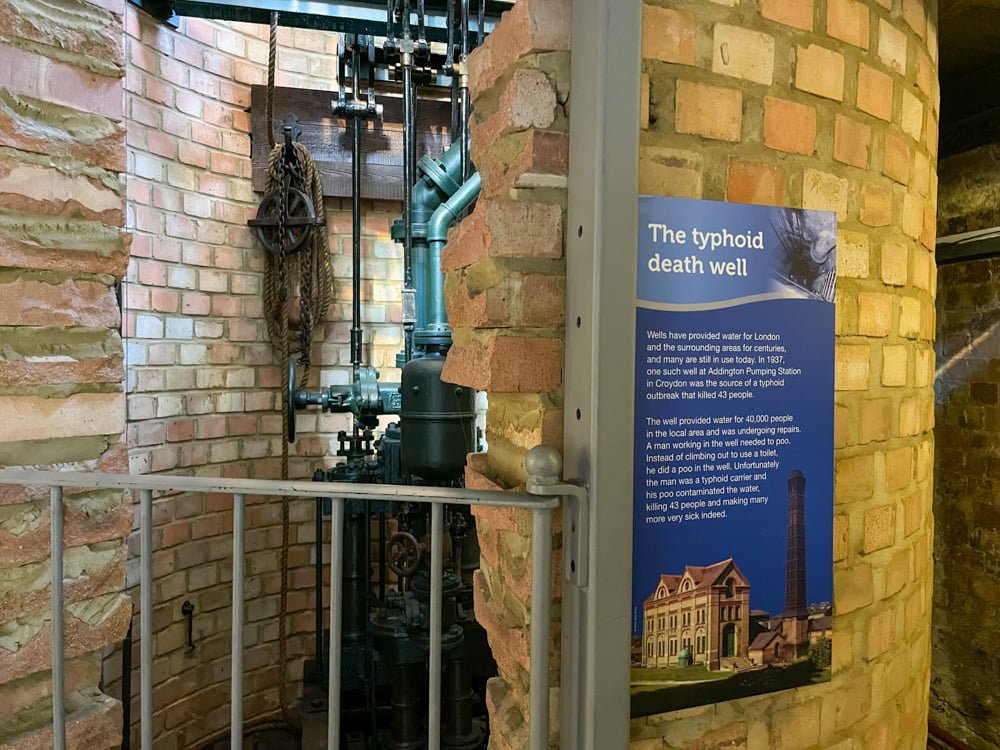
How London’s water system works today
London’s drinking water has dramatically improved over the years. However, water companies still face the challenge of dealing with water pollution. At the London Museum of Water & Steam, visitors can learn about the current filtration system.
The water treatment process also considers the potential water scarcity due to climate change, air pollution, and population growth. These new challenges differ from those of the past but are equally interesting to explore in the Waterworks Gallery.
London sewers and blockages
At the Museum of Water & Steam, we learned how most of London’s sewage pipes go back to the last century. Designed for a much smaller population than the current one, they need constant maintenance to remain functional.
One way to inspect sewers without requiring human entry is the robot mouse. In general, we were surprised to find out that water companies like Thames Waters spend millions of pounds annually to clear blockages in the sewer system.
One of the most incredible blockages occurred in 2017, known as the Whitechapel Monster – a monster of solidified grease, nappies, and wet wipes, weighing the same as 11 double-decker buses and as long as two football pitches!
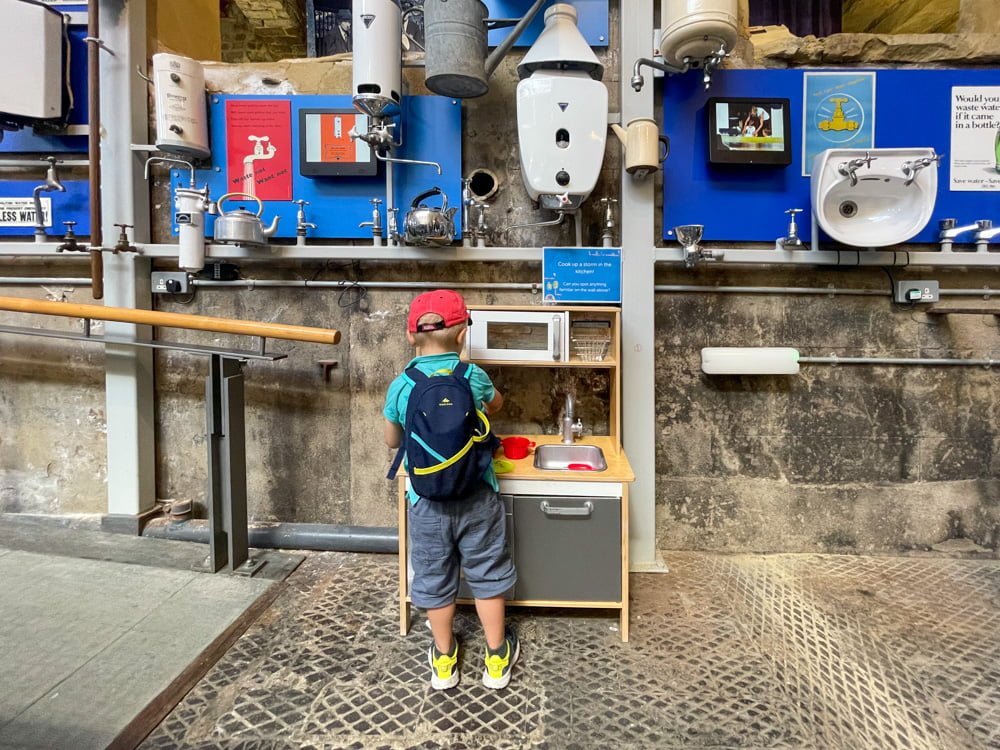
Steam engines and waterworks
The London Museum of Water & Steam is an exciting place showcasing the evolution of waterworks. It features several steam engines once used to pump water, providing a glimpse into how this technology developed. Before the Industrial Revolution, only human or animal power and occasionally windmills were used to move machinery.
The museum has many interactive stations explaining the science behind steam engines and their use. Visitors, especially children, can enjoy spinning wheels to understand how the machines function and see real live steam engines.
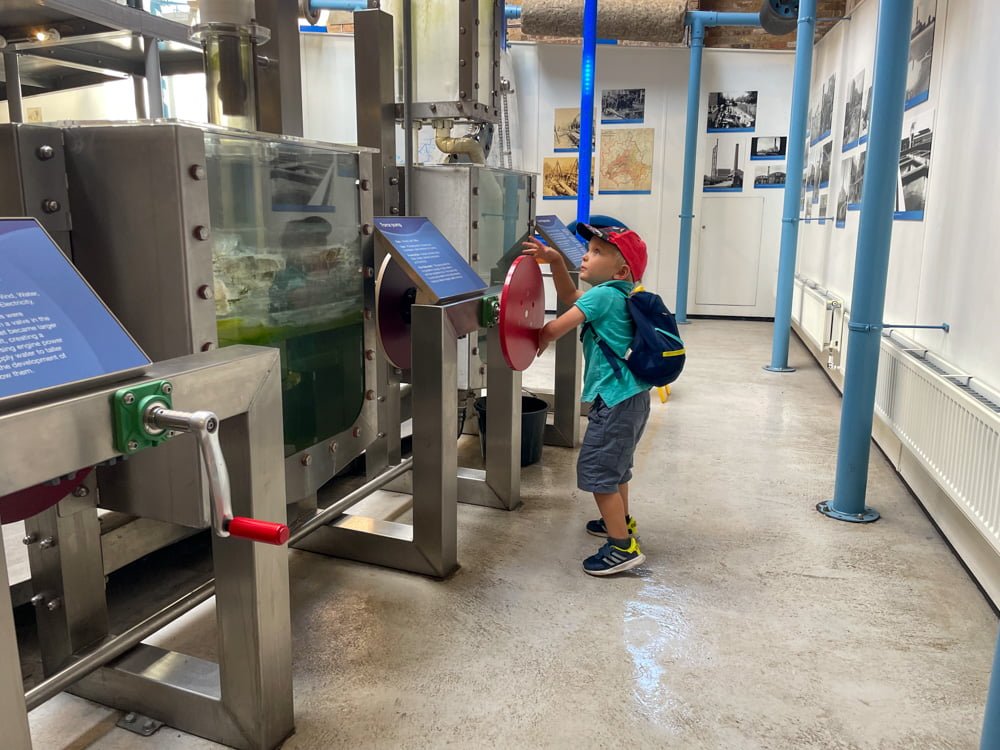
London Museum of Water & Steam with children
The London Museum of Water & Steam is an authentic industrial museum established on the premises of the Kew Bridge Waterworks company. The museum’s primary objective was to preserve steam-powered machinery not dismantled during and after the wars. It has now evolved into a remarkable family museum.
Children are welcome and encouraged to explore and interact with the exhibits. They can learn about the operation of steam engines in the field by turning wheels and pulling levers. The museum also uses models, doll houses, sinks, and toilets hanging on the walls to teach children about sewers.
You can easily spend the entire day at the museum, as there are many areas dedicated to the little ones. The museum has a fascinating exhibition that explains how London’s water supply system works, which children love. There is also a play area with Lego bricks and wooden trains where you can relax before or after lunch.
In summer, children can have fun in the Splash Area, an outdoor space with wheels, tubes, boats, and other materials that they can use to build their miniature aqueduct. If you decide to visit the London Museum of Water & Steam on a sunny day, bring a change of clothes for your child, as the Splash Area is ideal for playing with water on hot days.
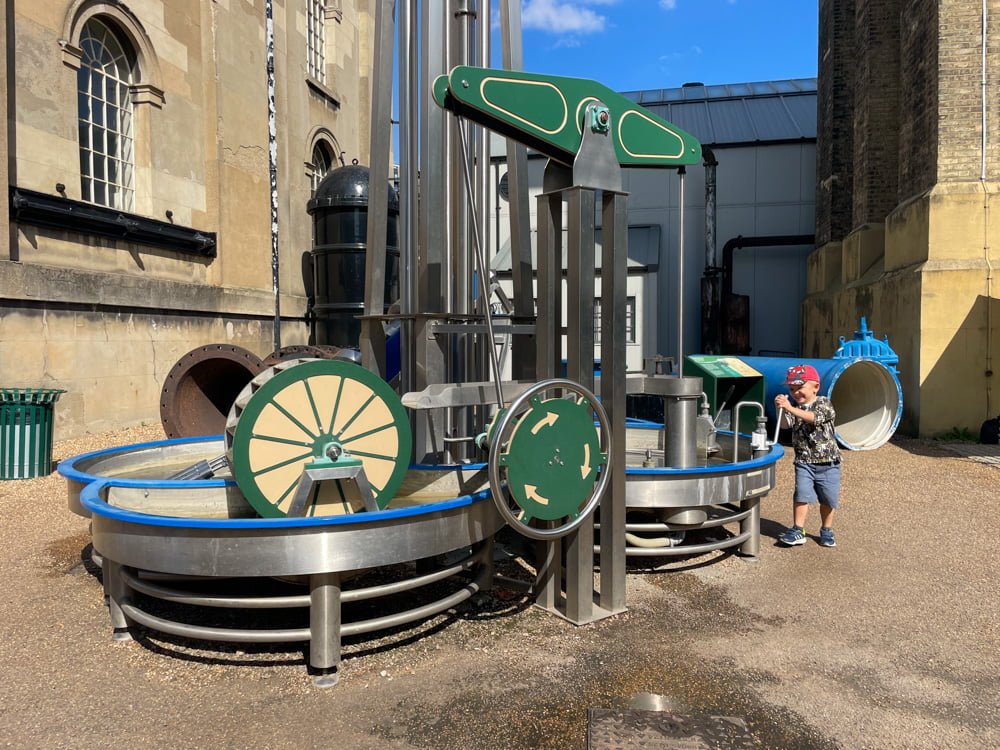
The museum with babies and young children
All male and female toilets are accessible and equipped with changing tables and potties. You can leave prams in the ticket office area, which also sells souvenirs, or you can take them with you. Bear in mind that there are steps in the museum because the building is the original old Kew Bridge Waterworks.
Practical info for visiting the London Museum of Water & Steam
The admission fee for adults is £18.00, while children can enter for free. Although the cost may seem high, it is worth it because the museum is captivating enough to keep you and your child engaged for an entire day.
The museum has interesting exhibits and attractions that cater to all age groups. Additionally, like other British museums, the ticket is valid for one year from your first visit so that you can revisit the museum anytime.
You can purchase a museum guide for approximately £5 at the ticket office, which I highly recommend. The guide provides a fascinating account of the history of the London waterworks and the Key Bridge Waterworks company. I find museum guides among my favourite souvenirs because when I reread them at home with my son, they help me relive our travels.
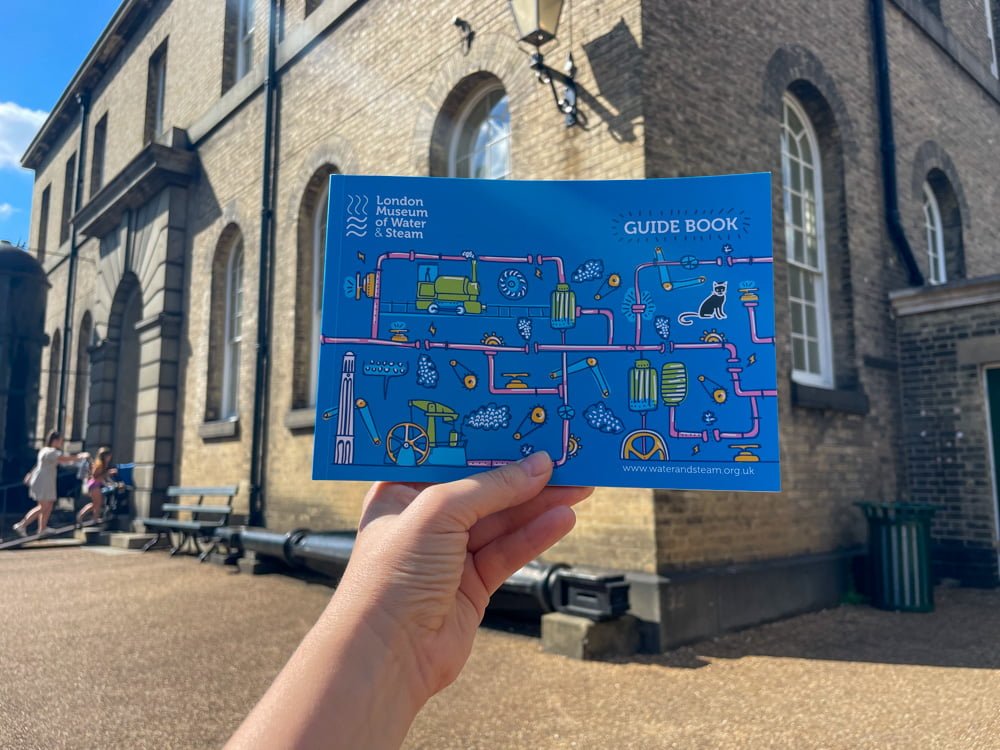
Where to eat in the London Museum of Water & Steam
You have two options for lunch: picnic at the Museum’s Splash Zone and garden or eat at the Pump and Grind Coffee Shop, an independent coffee shop run by the charity Our Barn. The menu at the coffee shop offers excellent toast, baked potato, and classic English cakes at reasonable prices.
Even if you already have a picnic planned, I suggest you drop by the coffee shop for a cup of coffee and a slice of cake. The Pump and Grind Coffee Shop also works as a training centre for young people with learning disabilities or autism who wish to enter the workforce. The food served at the coffee shop is of high quality.
How to get to the London Museum of Water & Steam
If you’re looking for a unique and off-beat attraction in London, you should check out the Museum of Water & Steam. Located on the city’s western outskirts, it’s far from the usual tourist spots, so you may not have heard of it before. This museum is situated where the Kew Bridge Waterworks company once operated.
Don’t worry if you don’t have a car; there is a car park, but it’s also well-served by public transportation. You can easily find the best route to get there from anywhere in London by using Google Maps. Buses, trains, and underground trains all have stops nearby.
London Museum of Water & Steam
Green Dragon Ln
Brentford TW8 0EN
Where to stay in London
London has a wide range of accommodation, from hostels to luxurious hotels, but it can be expensive. For a luxurious stay, I highly recommend the 5-star hotel Broadwick Soho, close to Piccadilly Circus, with refined and beautifully designed rooms, a terrace and a restaurant. A great choice is also the Hampton by Hilton London Waterloo, just a 5-minute walk from Waterloo train station and conveniently located near many popular attractions. Another option, if you are looking for a nice hotel with a limited budget, is the Assembly Covent Garden, a design hotel with well-decorated rooms and sculptures, ideal for those on a budget.
Although little known to tourists, the Museum of Water & Steam is one of London’s most exciting and fun museums to visit with children. Let me know in the comments if this post made you want to see it.
